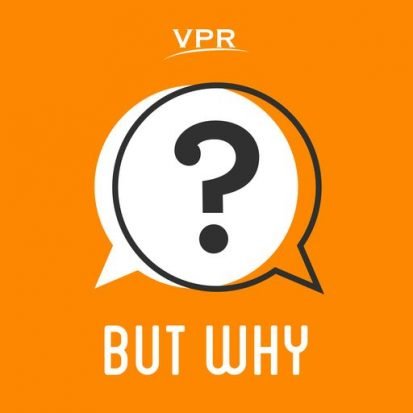
Why does the wind blow?
Leave a reviewWhat causes wind? How is wind created? Why does the wind blow in different ways? How does the wind start blowing and what makes it stop? Why is it windy by the ocean? Why does it get windy when the weather is changing? How is it you can you feel and hear the wind but not see it? Why is the wind sometimes strong and sometimes cold? Answers to all of your wind questions with National Weather Service Meteorologist Rebecca Duell.
© Vermont Public Radio | 30:21
|Episode: 171 |
Full episode description
 Episode One: But Why: Intro For Adults
Episode One: But Why: Intro For Adults
This is an Episodic show. You can listen to it in any order, but episode one is always a great place to start.Full Episode description
What causes wind? How is wind created? Why does the wind blow in different ways? How does the wind start blowing and what makes it stop? Why is it windy by the ocean? Why does it get windy when the weather is changing? How is it you can you feel and hear the wind but not see it? Why is the wind sometimes strong and sometimes cold? Answers to all of your wind questions with National Weather Service Meteorologist Rebecca Duell.
Download our learning guides: PDF | Google Slide | Transcript
Wind is just the air around us moving. The atmosphere always wants to be in balance. Some areas of the atmosphere have more air pressure than others. When there’s a pressure imbalance, the higher pressure air moves to fill a vacuum left by lower pressure air.
The wind starts blowing when that balance is off – when one area is heated more than another area. That heat comes from the sun. Warm air will rise and cold air will sink. When one area is heated that warm air will start to rise. Air at the surface will be rushing to fill that area where the air is rising.
Wind near the ocean is called a sea breeze. The land is absorbing more heat from the sun than the ocean water absorbs. As the less dense warm air over the land starts to rise and the cooler, the more dense air over the ocean rushes in to fill the space. If there’s enough moisture in the air when it rises, it will cause rains, which is why you often get afternoon rain and thunderstorms in places like Florida.
The wind can be hot or cold depending on where that air is coming from. The northern winds will be colder, winds from the south will be warmer. (In the northern hemisphere. It’s opposite in the southern hemisphere.)
Related Episodes
How Do Meteorologists Predict the Weather?
Experiment
One way to see the wind is to put some steam or smoke into the air. Which way is it blowing? Be sure to have an adult help you! Or you can look at a smokestack or chimney. Which way is the smoke blowing? Are there other ways you can see the wind?
© Vermont Public Radiobop| Status: Active, 259 episodes | Kind: Episodic | Episode URL
The content, Artwork and advertising within this podcast is not owned or affiliated with Sound Carrot and remain the property of their respective owners.








